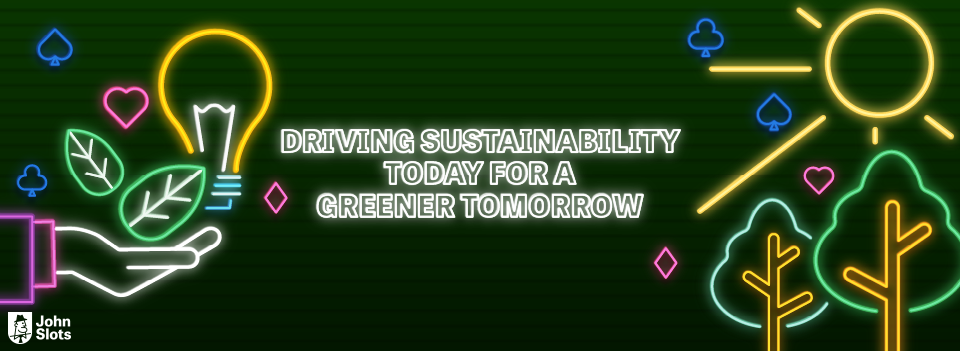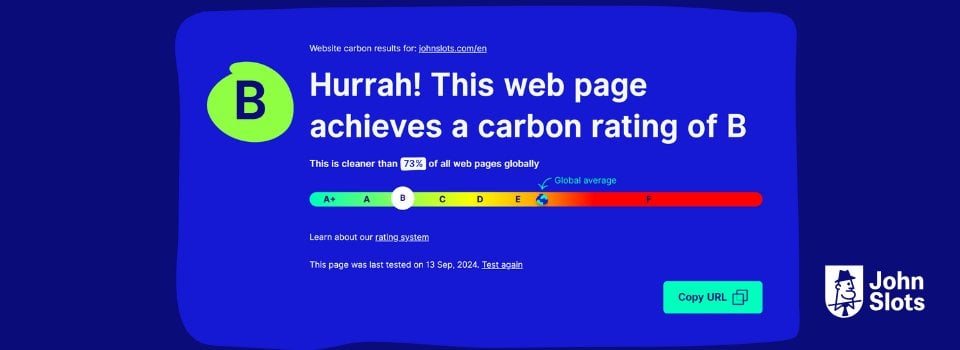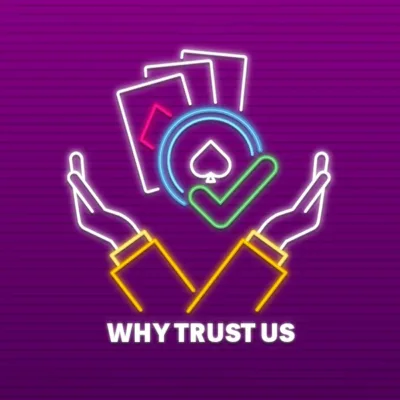
The Environmental Challenges in the Gambling Industry
The online gambling industry may not be the first that comes to mind when thinking about carbon emissions because the intangible nature of online games is assumed to have a trivial impact on the environment.
However, like any other industry, gambling has a huge impact on the environment due to the following challenges:
High Energy Consumption
Energy consumption in the gambling industry is one of the most significant contributors to its environmental impact.
Most websites operate around the clock, and the servers and data centres that power them require vast amounts of energy to run. They also need vast amounts of energy for heating, lighting, and cooling – increasing carbon emissions.
While the high energy consumption already leaves a huge carbon footprint, it is only going to get worse. The gambling industry continues to expand and more casinos are switching to the more energy-intensive blockchain-based games, increasing energy consumption and its environmental impact.
Waste
Gambling platforms generate a lot of electronic waste. Technology advances at a rapid speed so computers, tablets, smartphones, and other gaming technology can become obsolete very quickly.
While some casinos replace and dispose of their electronics properly, many still dispose of them irresponsibly, exacerbating environmental contamination. Also, the materials used and manufacturing process followed when creating these electronics have their impact on the environment.
Other types of waste in the gambling industry that can contribute to environmental degradation include food waste and non-recyclable advertising materials from the gaming company.
Software Development
Developing affiliate casino or sportsbook websites involves resource intensive processes like:
- Coding
- Testing
- Debugging
- Updating
These processes, as well as the electricity required to run them, consume a lot of energy. And, it will only grow as the popularity of online casinos expands.
User Engagement
Every time a player interacts with a gaming platform, they have an impact on our environment, however small. By interacting, we mean activities like:
- Signing up
- Playing games
- Making deposits
- Claiming bonuses
- Making withdrawals
- Contacting customer support
All of them require computing resources that contribute to carbon emissions.
JohnSlots’ Sustainable Practices
At JohnSlots, we recognise our impact on the environment. We are constantly working to minimise it and contribute to a more sustainable future. As part of these efforts, we have embraced the following sustainability practices.
Our Parent Company’s Environmental Cause
At our parent company, Gentoo, sustainability isn’t just a buzzword—it’s a core value that guides every decision made.
Gentoo is dedicated to ensuring all operations and procedures align with the Corporate Sustainability Reporting Directive, The Ten Principles of the United Nations Global Compact, and the 17 Sustainable Development Goals. To achieve this, it reduces and offsets the carbon footprint of its operations and employees through:
- Partnering with Greenly to measure Scope 1, 2, and 3 greenhouse gas emissions to implement reduction, decarbonisation, and offsetting plans
- Growing #GiGMediaForest with Tree-Nation
- Promoting paperless offices
- Measuring and offsetting travel emissions using TravelPerk and GreenPerk
- Reduced travel emissions, by preferring digital meetings
- Promoting green travel methods – most employees come to work by foot or bycicle
- Recycling in all office locations
- Smart energy consumption
- Eco-friendly merchandise
Gentoo believes sustainability is everyone’s responsibility and recently, it introduced an initiative that gives everyone an opportunity to offset their carbon footprints. It offers a welcome gift for all new starters to plant trees on their behalf in the #GiGMediaForest.
The objective of the initiative is to help reforest the world and support local communities in building a better future.
CO2 Badge
A CO2 badge symbolises that a website has offset its carbon emissions. It shows that a website supports environmental initiatives like tree planting and renewable energy projects to compensate for the total CO2 emissions caused by its operations.
JohnSlots is a proud owner of a CO2 badge, which proves that we have successfully neutralised our CO2 emissions. Still, we are ramping up our efforts to further reduce our emissions and create a truly sustainable business.
Reducing Carbon Footprint
According to websitecarbon.com, the average website produces about 0.8 grams of carbon dioxide per page view. So, if a page has 10,000 page views per month, it emits 96 kg of CO2 per year.
At JohnSlots, our web pages emit only 0.25g of CO2 per visit, making us cleaner than 73% of all websites in the world. That means 10,000 views per month emit only 29.51kg of CO2 in a year—an amount that only two trees absorb at the same time.
While this is remarkable, we still have a long way to go and we’re constantly improving our website and operations.

According to Websitecarbon, JohnSlots is cleaner than 73% of the websites
Page | Carbon Footprint (Average CO2 in mg) |
|---|---|
7.419 | |
6.463 | |
8.887 | |
13.688 | |
10.383 | |
7.801 | |
9.641 | |
7.296 |
To calculate the advanced carbon footprint of our website pages, we followed these steps:
- Data Collection: We measured data transfer (GB) for each page.
- Sustainable Web Design Model: We applied the Sustainable Web Design Model (SWDM), which uses data transfer as a proxy to estimate emissions across three key components: data centres, networks, and user devices.
- Energy Intensity Calculation: We determined energy intensity (kWh/GB) for each component based on global energy consumption and internet data transfer volumes.
- Operational Emissions: Emissions were calculated by multiplying data transfer by energy intensity and the global average carbon intensity (gCO2e/kWh).
- Embodied Emissions: We included embodied emissions for data centres, networks, and devices based on their share of energy consumption during production.
- Total Emissions: The total carbon footprint (gCO2e/page view) was calculated by summing operational and embodied emissions.
To better understand the method we’ve used, read Sustainablewebdesign’s take on digital emissions calculation “What is the Sustainable Web Design Model?“.
7 Ways We Maintain Sustainability
Some of the measures we have implemented to minimise our carbon emissions and maintain sustainability include:
Compression
Our website compresses HTML, CSS, and JavaScript files to make them smaller before sending them to a visitor’s browser. Smaller files require less processing power and bandwidth to load, so they reduce the energy consumed by the servers and the user’s device.
Browser Caching
When you visit a page for the first time, your device downloads website resources, such as images, scripts, and stylesheets for a seamless experience. It requires a lot of bandwidth and processing power, especially if you are a regular visitor.
To avoid this, our website temporarily stores copies of the website resources on your device, so you won’t have to download everything from the server every time you visit us. It reduces server requests and consequently, the energy we use to transmit data to frequent visitors. This helps advance our eco-friendly website agenda.
HTTPS
Our website uses HTTPS instead of HTTP, which is more secure as it encrypts the communication between your browser and our website.
While it primarily helps with security, using HTTPS helps in our sustainability initiatives as modern browsers often handle HTTPS more efficiently than HTTP. This means lower energy usage which leads to less carbon emissions.
Lazy Loading
Lazy loading is a technique used in web design to avoid loading an entire webpage at once. Instead, it only renders the parts you need and loads more as you scroll. This technique can speed up page web performance and save bandwidth by not loading the resources that you don’t need.
Our website uses lazy loading to minimise the volume of data needed per page visit. Less data requires less energy to load and process, so it helps us reduce our emissions.
Compressing Images
Images are often the most significant contributor to the size of a web page. The greater the number of images on a web page and the larger they are, the more the energy you need to load the page.
Our website compresses all the images to reduce their file size without compromising quality significantly. This reduces the amount of data that needs to be transmitted from the server to the user’s device, minimising energy consumption.
Green Hosting
Green hosting involves partnering with a web hosting services provider that uses renewable energy to operate or actively offsets their carbon footprints. It significantly reduces the carbon footprint associated with website operations. For the full list of verified green web hosts, check out the Green Web Foundation’s directory.
JohnSlots is hosted by Cloudflare, a green host that is powered by 100% renewable energy, aligning with our eco-friendly practices.
Paperless Office
At JohnSlots, we rely on digital documentation—we store and manage documents electronically to minimise the need for physical paper.
By reducing paper use, we minimise the environmental impact of the deforestation, energy consumption, and waste production involved in paper manufacturing and disposal.
JohnSlots’ Commitments to a Green Future
Despite the steps we have made so far, we still have a lot of ground to cover to realise the green future we envision. To work towards it, we have broken down our sustainability goals into the following targeted, measurable, and achievable goals.
Net-zero operations by
2032
Reduction of 1 & 2 emission intensity by
20% by 2025
Electricity from renewable sources
20% by 2030
Reduce waste by
10% by 2025
- Net-zero operations by 2032: We will no longer be contributing to climate change by 2032—we aim to minimise our carbon emissions as much as possible and offset the remaining emissions by investing in more carbon reduction projects.
- Reduction of company-wide scope 1 & 2 emission intensity by 30% by 2025: Over the next couple of years, we will have decarbonised our direct and indirect carbon operations by at least 30%.
- JohnSlots commits to sourcing at least 20% of its electricity consumption from renewable sources by 2030 — By 2030, we will ensure that at least half of the electricity we use comes from renewable sources like solar, wind, and hydropower. The goal is to reduce reliance on fossil fuels, which are major contributors to climate change.
- JohnSlots aims to reduce waste by 10% and achieve better recycling capabilities in our offices by 2025: We will improve the waste management practices in our offices, such as recycling, to reduce our waste generation by at least 10% by 2025.
By pursuing these goals, we hope to make a significant contribution to the global efforts of building a greener and more resilient planet for future generations.
Have questions about our sustainability initiatives or want to collaborate on green projects?
✉️ Contact us to learn more about our commitment to environmental responsibility and how we’re making a difference.
References:
- 📋Statista (Accessed: September 23, 2024) Online Gambling – Worldwide | Statista market forecast. https://www.statista.com/outlook/amo/online-gambling/worldwide.
- 📋Gaming Innovation Group Inc and Edward, G. (2023) Sustainability Report 2023. https://www.gentoomedia.com/wp-content/uploads/2024/05/GiG_SustainabilityReport_2023.pdf.
- 📋How to make your website CO2 neutral | CO2 Neutral Website (Accessed: September 23, 2024). https://www.co2neutralwebsite.com/how-does-it-work.
- 📋Wholegrain Digital (2024) Johnslots.com/en – website Carbon calculator. https://www.websitecarbon.com/website/johnslots-com-en/.
- 📋The Green Web Foundation (2024) The Green Web Directory – Green Web Foundation. https://www.thegreenwebfoundation.org/directory/.
- 📋Cloudflare (September 23, 2024) Making the CloudFlare network more efficient. https://www.cloudflare.com/impact/ (Accessed: September 23, 2024).
- 📋European Environment Agency’s home page (Accessed: September 23, 2024). https://www.eea.europa.eu/en.
- 📋Alliance, E.-F.W. (September 23, 2024) Eco-Friendly Web Alliance | For a cleaner greener internet. https://ecofriendlyweb.org/.
- 📋Carlson, K.M. (2019) Greener Gaming Products: Considering Environmental Impacts When Assessing Gambling-Related Harms. thesis. Harvard Extension School. https://dash.harvard.edu/bitstream/handle/1/37365013/CARLSON-DOCUMENT-2020.pdf.










